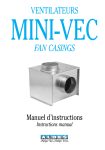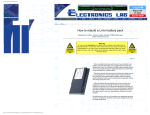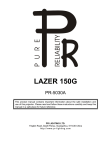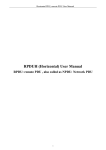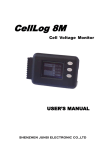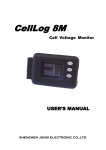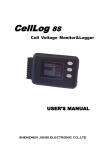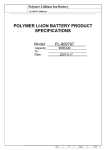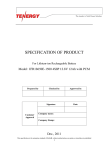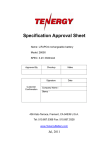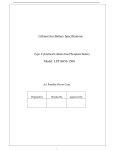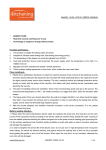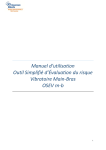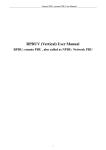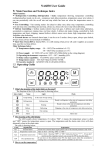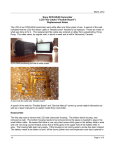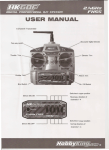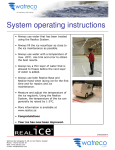Download MINAMOTO
Transcript
The Source of Electric Power ® MINAMOTO 1. Website: www.minamoto.com e-mail: [email protected] Scope This product specification has been prepared to specify the rechargeable Lithium-ion Polymer battery to be supplied to the customer by MINAMOTO BATTERY (HK) LTD. 2. Description and Model 2.1 Description: 100AH Lithium Iron Phosphate Battery with rectangular steel case 2.2 Model: LFP75136250 3. Nominal Specifications Item Nominal Capacity Specification Remark 100Ah Discharged at 0.2C (12A) Rate Voltage 3.2V 0.2C average discharge voltage 3.3 Impedance 10m 3.4 3.5 3.6 3.7 3.8 3.9 3.10 3.11 Discharge cut-off voltage Charge current Charge voltage Max charge voltage Charging time Max charge current Max discharge current 2.50V 20A 3.5V 3.65V 6.5h 100A 500A Cycle life > 3000 cycles 3.12 3.13 Weight <5 kg Thickness :75±0.5mm Width : 136±0.5mm Height : 250±0.5mm Charge: 0~50ºC Discharge: -20~70ºC 1 month : -20ºC ~ +45ºC 3 months : -20ºC ~ +35ºC 1 year : -20ºC ~ +30ºC 3.1 3.2 Size 3.14 Range of work temperature 3.15 Store temperature 4. 0.2C standard charge 1C 5C Remaining capacity >80% The best temperature in transport is 20ºC Capability 4.1 Standard test conditions The battery for test must be new produce left factory no more than 1 month and charge-discharge less than 10 circles. Unless otherwise specified, all tests stated in this specification shall be conducted at the temperature of 20±5ºC and the relative humidity of 65±20%RH, if it is judged that the test results are not affected, the tests may be conducted at a temperature in the range from 15ºC to 30ºC and a relative humidity in the range from 25%RH to 85%RH. **Note: The data in this document are for descriptive purposes only and subject to change without prior notice. Minamoto Battery Ltd. Flat A-6, 8/F., Mai Hing Industrial Building, 16-18 Hing Yip Street, Kwun Tong, Hong Kong. Tel: (852) 2793 4790 Fax: (852) 2793 4932 The Source of Electric Power Website: ® MINAMOTO www.minamoto.com e-mail: [email protected] 4.2 Measuring Equipment (1) Slide caliper should have an accuracy of the grade 0.01mm or higher. (2) The ammeter and voltmeter should have an accuracy of the grade 0.5 or higher. The impedance of voltmeter should be more than 10K /V. (3) The impedance meter with AC 1kHz should be used. (4) For the battery testing system, the accuracy of current should be more than ±0.1%. The accuracy of voltage should be more than ±0.5% and the accuracy of calculagraph should be more than ±0.1%. (5) The thermometer should be have an accuracy of the grade 0.5ºC or higher. 4.3 Standard charge 0.2C 3.5V (CC-CV), cut-off current is 0.01C, total charging time no more than 6.5 hour. 4.4 Rest time Unless other wise specified, between battery charging and discharging, there is a 30 min interval. 4.5 Initial performance testing Item 1. Open voltage 2. AC impedance 3. Nominal capacity Testing method Measure the open voltage of the battery within 24 hour after the standard charge. Measure the impedance of the battery at AC 1KHz, 25±5ºC. Discharge the battery at a constant current of 0.2C to 2.5V after standard charge and deposited 30 min, measure the discharge capacity. Requirement 3.3V 10m 60AH 4.6 Electricity characteristics (1) Temperature dependence of the discharge capacity Heat or cool the battery to the testing temperature within 30 min and rested for 2 hours after standard charge at 25±2ºC, measure the capacity when discharged at a standard discharge condition (0.2C) and at each temperature. When a test finished, charge the battery after 2 hours. Discharge temperature Discharge capacity -20ºC 70% 0ºC 85% 25ºC 100% 60ºC 105% **Note: The data in this document are for descriptive purposes only and subject to change without prior notice. Minamoto Battery Ltd. Flat A-6, 8/F., Mai Hing Industrial Building, 16-18 Hing Yip Street, Kwun Tong, Hong Kong. Tel: (852) 2793 4790 Fax: (852) 2793 4932 The Source of Electric Power Website: ® MINAMOTO www.minamoto.com e-mail: [email protected] (2) Cycle life Measure capacity under the cycle conditions described below, until the discharge capacity continuously, 80%C1.0 for three times. Requirement: cycle life 3000 cycles. Charge at 0.2C initially and then charge at constant voltage of 3.5V, for 2.5 hour in total, at 25±2ºC. Rest for 30 min. Discharge at 0.5C to 2.50V cut-off. (3) Electric charge holding characteristics Item 1. General Temperature 2. Item 1. High Temperature 2. Testing method Store the battery, which is charged at standard charge condition, for 30 days at 25±2ºC. Measure the remaining capacity of the battery at standard discharge. Charge and discharge at 0.5C for 3 cycles. Measure the get back capacity (the max discharge capacity for three cycles) Requirement 90% Testing method Store the battery, which is charged at standard charge condition, for 30 days at 45±2ºC. Measure the remaining capacity of the battery at standard discharge. Charge and discharge at 0.5C for 3 cycles. Measure the get back capacity (the max discharge capacity for three cycles) Requirement 80% 95% 90% (4) Long-term storage characteristics The battery used for this test must less than 3 months between manufacture to test. Storage the battery at 25±2ºC for 3 cycles. Measure the get back capacity (The max discharge capacity for three cycles). Requirement: Get Back capacity 90%. 4.7 Mechanical performance Item Constant humidity and temperature test Vibration test Test method Put the battery into an oven of constant humidity (90%~95%) and constant temperature (40±2ºC), rest for 48 hours, take it out and rest for 2 hours at 25±2ºC, then discharge at 0.5C to 2.50V cut-off. Fix the battery on a vibratile table, vibrate it at X, Y, Z orientation. Change the frequency of vibration with 1Hz/min from 10Hz to 55Hz, redo it for 30 min. Frequency: 10~30Hz Swing distance: 0.38mm Frequency: 30~55Hz Swing distance: 0.19mm Requirement 80% No leakage, reek and explosion. The voltage of battery3.2V. **Note: The data in this document are for descriptive purposes only and subject to change without prior notice. Minamoto Battery Ltd. Flat A-6, 8/F., Mai Hing Industrial Building, 16-18 Hing Yip Street, Kwun Tong, Hong Kong. Tel: (852) 2793 4790 Fax: (852) 2793 4932 The Source of Electric Power ® MINAMOTO Free fall test Do the free drop test according to the condition described below after finished the vibration test. Attitude: 1.0mm Receiver: a hard board of 18~20mm. Orientation: two sides of battery at horizontal. Discharge the battery to 2.5V at 0.5C, and charge-discharge the battery 3 cycles, measure the discharge capacity. Website: www.minamoto.com e-mail: [email protected] Remaining capacity 85% C1.0. The get back capacity 90% C1.0. 4.8 Safety performance Item Impact test High temperature test Over charge test Over discharge test Short-circuit test Heat impact Puncturing Crush Test method Make a hammer (weight:10kg) free-drop from an altitude of 1 meter, impact the battery which reveted on the table. (Put the max area side of battery on table perpendicularly.) Put the battery in an oven with 90ºC for 4 hours after standard charge, discharge the battery to 2.50V at 0.5C and redo three times, measure the get back capacity. Charge the battery at 3.0CmA to 10.0V after standard charge, checking the range of temperature on battery, when the temperature of battery flow down 10C from the highest the test is end. Connect the positive and negative of battery with external load of 10 after standard charge, and store the battery for 15 days, then charge and discharge at 0.5C for 3 cycles, measure the get back capacity. Short circuit the positive and negative of battery, checking the range of temperature on battery, when the temperature of battery flow down 10ºC from the highest the test is end. (Resistance of circuit less than 50m. Place fully charged cell in oven, increase temperature by (5ºC±2ºC) /min until reaching 150ºC± 2ºC. Maintain temperature for 30 minutes. After charging cell with 0.5C current, puncture a 2.0-3.0mm diameter steel nail through the center of the cell’s flat side until nail is visible on the other side. Put the battery in the Iron mould after standard charge, then compressing the battery with pressure of 13KN Requirement No fire and no explosion 80%C1.0 No fire and no explosion The get 80% back capacity No fire and explosion if the temperature of battery less than 150ºC. No fire and no explosion No fire and no explosion No fire and no explosion **Note: The data in this document are for descriptive purposes only and subject to change without prior notice. Minamoto Battery Ltd. Flat A-6, 8/F., Mai Hing Industrial Building, 16-18 Hing Yip Street, Kwun Tong, Hong Kong. Tel: (852) 2793 4790 Fax: (852) 2793 4932 The Source of Electric Power Website: ® MINAMOTO 4.9 4.9.1 www.minamoto.com e-mail: [email protected] Feature curve Cycle life Capacity Ratio 110% 100% 90% 80% 70% 60% 50% 500 1000 1500 2000 2500 3000 3500 Cycles 4.9.2 Temperature dependence of the discharge capacity Voltage V 60ºC 3.5 25ºC 3.3 3.1 0ºC 2.9 2.7 -20ºC 2.5 10% 20% 30% 40% 50% 60% 70% 80% 90% 100% 110% Capacity Ratio 5. Guarantee period The quality guarantee period from the production date (printing) began to take six months. 6. User manual For the use of the battery exactly, the customer should strictly observe the items described below. The defects other than those caused by user overstep this specification shall be excluded from the warranty of MINAMOTO BATTERY (HK) LTD. * Do not throw the battery into water or moisten the battery. * Do not use or storage battery near calorific source such as fire and heater. * Please use the first wife charger. * Do not connect the terminals of battery by the wrong way. **Note: The data in this document are for descriptive purposes only and subject to change without prior notice. Minamoto Battery Ltd. Flat A-6, 8/F., Mai Hing Industrial Building, 16-18 Hing Yip Street, Kwun Tong, Hong Kong. Tel: (852) 2793 4790 Fax: (852) 2793 4932 The Source of Electric Power Website: ® MINAMOTO www.minamoto.com e-mail: [email protected] * Do not throw the battery into fire or heating the battery. * Do not short circuit the battery’s terminals with wireless or metal. Prevent storage or transport the battery with necklace, barrette or other metal object together. * Prevent impacting, throwing, bending, twisting, mechanical shock from battery. * Prevent piercing the case of battery with sharp edge such as pin, needle. Do not hammering, trampling battery. * Never disassembling the battery in any way. * Do not mix our battery with one-off battery (such as dry battery) or different performance together. * If electrolyte drop into eyes, do not wipe, please wash with clear water and consult a doctor immediately, or the eyes may be harmed. * If battery leakage out and the electrolyte come into contact with skin or clothing, please wash the area with water immediately or the skin will be harmed. * If your equipment do not use for a long time, take the battery away and storing it in a dry and cool place, or the battery will rust and go to the bad. Clear the terminals of t battery with dry cloth if they are dirty, or the battery will not be contacted well and can not charge. 7. Initial status of battery 7.1 The battery should be charged a half electric power, and the voltage >3.2V. 7.2 The surface of battery should be clean and without scratch, contamination, distortion, leakage, bilge gas etc. Outline dimensional drawing: LFP75136250 Resettable valve to prevent excessive pressure T W H Characteristic T W L Description Thickness Width Height Size 75±0.2mm 136±0.5mm 250±0.5mm **Note: The data in this document are for descriptive purposes only and subject to change without prior notice. Minamoto Battery Ltd. Flat A-6, 8/F., Mai Hing Industrial Building, 16-18 Hing Yip Street, Kwun Tong, Hong Kong. Tel: (852) 2793 4790 Fax: (852) 2793 4932






